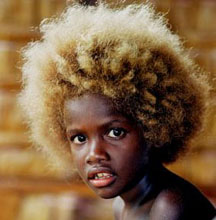Surviving the South Pacific

Over the years, I have read books about the South Pacific that contained pictures of naturally blond-haired Black children. Seeing people of color with naturally-blond hair intrigued me. It is their presence that initially lured me to the South Pacific.
My seven-week journey took me to Australia, Papua New Guinea, The Solomon Islands, and New Zealand, where the original inhabitants are Malanesians, who are black-skinned, or Polynesians, who are brown-skinned. Today, most of the citizens of Australia and New Zealand are descendants of Europeans.
After my four-hour flight from Washington, D.C. to Los Angeles, followed by my long, but pleasant 13-hour transpacific flight from Los Angeles to Cairns, Australia, I spent the first five days in the resort town of Cairns. When the Europeans arrived in Australia in 1770, they called the people on the mainland Aborigines. The story of the black-skinned Aborigines is similar to that of Native Americans. Europeans took the best land, killed the Aborigines, and didn’t grant them the right to vote until 1962.
The sexual customs on the Island are different from many other places. Teenagers are encouraged to have as many sexual partners as they choose until marriage.
While in the area, I saw several Aborigines and followed them into a recreation center. The center is what an American would label a bar and I got my first taste of Australian segregation. The Australians of British descent mainly occupied the side of the bar that was set-up more like an attractive sit-down restaurant. The Aborigines occupied the dingy side with a bar and a worn pool table. After I digested what I saw, I figured that legal segregation in the U.S. must have created similar scenes.
Before leaving America, I knew that I needed permission from Aborigine elders to visit their villages. I was hoping that I would be able make the connections upon arrival. Instead, either flooded roads or no trespassing signs prevented me from reaching my goal.
Read More
Also See: 100 Black 2 Egypt






